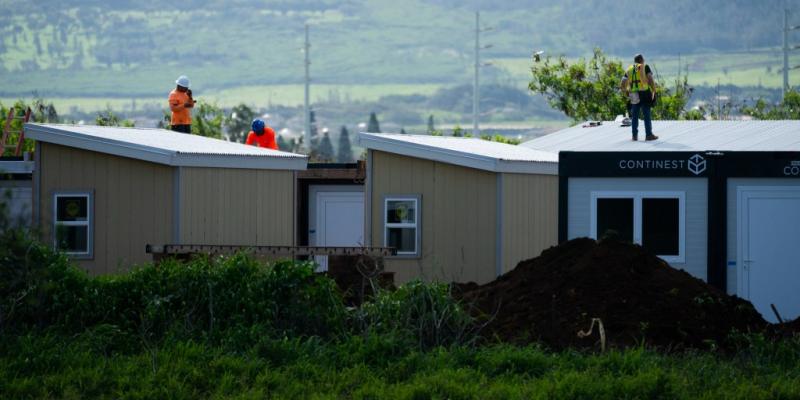Maui wildfire victims wait for housing as a tiny home village sits mostly empty
Category: News & Politics
Via: perrie-halpern • 9 months ago • 0 commentsBy: Steve Patterson and David Douglas



LAHAINA, Hawaii — Twelve days after a massive fire tore through the historic town of Lahaina, killing at least 102 people and destroying nearly 2,200 structures, Maude Cumming rushed to break ground on housing for survivors.
Through the Family Life Center, her Maui-based nonprofit organization, Cumming planned to build an 88-unit village of modular homes.
A year later, just 10 units are occupied, fueling frustration in a community fighting to heal and recover amid continued housing insecurity.
"People are still not settled," Cumming said. "The need is real."
Designs for the village include 16 pods, each with a private kitchen and bath, surrounding a community center with a large lanai, or open-sided veranda, intended to reflect the traditional Hawaiian way of life. Inside are a large communal kitchen and laundry facilities.
Funded by $14 million in private donations, the village began to take shape within weeks of the fire, but construction soon stalled because of bureaucratic obstacles.
Local building codes required the project to meet commercial standards, and access to a county water line was slowed by preservation efforts, Cumming said.
"Because it was a disaster, we felt like it might go quicker than normal," she said of the permitting process. "We had great hopes."
Instead, a village that could house more than 300 people has fewer than 30 residents.
A year after the deadliest fire in Hawaii's history, housing insecurity remains one of the biggest hurdles for survivors. A recent survey of Maui residents by the Hawaii State Rural Health Association found that 59% of fire-affected people have moved at least three times since last August.
Nearly 1 in 5 respondents said they have moved five or more times.
Cumming said she is aware of families that have moved as many as eight times as various housing programs have expired or as tensions grew between families or friends offering places to stay.
The instability has rippled through the once-tightknit community, scattering families across Maui and forcing some people to leave the island because of rising rents.
Short-term housing was found for all the families that lost their homes, but long-term solutions remain a challenge largely because rents are so high, according to Gov. Josh Green's office.
In the days and weeks after the fire, disaster teams sprang into action to help survivors, including temporarily sheltering thousands of people in hotels and later coordinating with local officials and private organizations to secure interim housing for 13,000 displaced people.
"Year one was survival. Year two is rebuilding," Green told NBC News.
Nearly 8,000 people were moved into hotel rooms in the first two weeks after the fire, and 662 survivors moved into short-term rentals, according to the state Department of Human Services.
Since then, displaced families have received aid through a combination of rental assistance programs, interim housing and disaster case management.
The first 10 families will soon move into a temporary housing project designed to shelter 1,200 people for up to five years. And 3,000 people have people have found accommodations through a partnership with Airbnb, the Human Services Department said.
As for Cumming's project, she aims to finish it within the next few months after the Family Life Center receives delivery of a water pipe that will allow the modular home village to connect to a county water line, she said.
"I would like this to be a model for disaster response," she said. "This is what's safe. This is what can be thrown up in a short amount of time. If we can accomplish that, I would say it's been worth it."
The project sits empty while people continue to wait for housing, Green said, but "there are trade-offs when you have a crisis like this."
"In general, you want to be doing larger projects that are more permanent," he said.
But Cumming said she can hear worry in the voices of people who don't know what will happen in the next two or three months.
"It's that uncertainty that has people still on pins and needles," she said.




